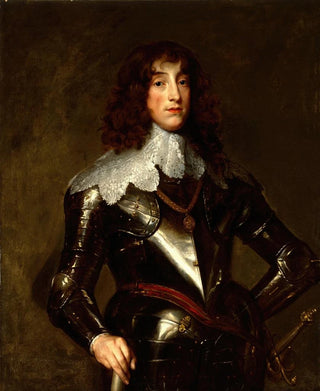Art print | Charles Louis Elector Palatine - Antoine van Dyck


View from behind

Frame (optional)
In the world of Baroque painting, few works manage to capture the essence of a character with as much mastery as "Charles Louis Elector Palatine" by Antoine van Dyck. This iconic piece not only depicts a noble figure but also evokes an era where art and politics were inextricably intertwined. Through the penetrating gaze of the prince, the artist succeeds in conveying a psychological depth that transcends a simple portrait. The viewer is immediately transported into the courtly universe, where power and beauty coexist, offering an immersive experience into the history and grandeur of the 17th century.
Style and uniqueness of the work
Antoine van Dyck's style is distinguished by his ability to combine realism with a certain idealization. In this portrait, the composition is carefully orchestrated, with every detail designed to enhance the stature of the character. The sumptuous drapery of the prince's attire, richly colored and subtly illuminated, testifies to unparalleled craftsmanship. The use of light, which caresses the prince's face while creating delicate shadows, gives the work an almost lifelike dimension. This approach, characteristic of the Baroque, not only highlights Charles Louis's personality but also creates an atmosphere imbued with majesty and gravity. Van Dyck, through his choice of colors and painting technique, manages to establish a dialogue between the subject and the viewer, making this portrait eternally captivating.
The artist and his influence
Antoine van Dyck, a pupil of Rubens, established himself as one of the greatest portraitists of his time. His career, marked by stays in Italy and England, allowed him to develop a unique style that blends Flemish tradition with Italian influences. Van Dyck not only redefined aristocratic portraiture but also influenced many artists across the centuries. His approach to portraiture, which emphasizes psychology and character, paved the way for a new way of conceiving individual representation. Thus, the work "Charles Louis Elector"

Matte finish

View from behind

Frame (optional)
In the world of Baroque painting, few works manage to capture the essence of a character with as much mastery as "Charles Louis Elector Palatine" by Antoine van Dyck. This iconic piece not only depicts a noble figure but also evokes an era where art and politics were inextricably intertwined. Through the penetrating gaze of the prince, the artist succeeds in conveying a psychological depth that transcends a simple portrait. The viewer is immediately transported into the courtly universe, where power and beauty coexist, offering an immersive experience into the history and grandeur of the 17th century.
Style and uniqueness of the work
Antoine van Dyck's style is distinguished by his ability to combine realism with a certain idealization. In this portrait, the composition is carefully orchestrated, with every detail designed to enhance the stature of the character. The sumptuous drapery of the prince's attire, richly colored and subtly illuminated, testifies to unparalleled craftsmanship. The use of light, which caresses the prince's face while creating delicate shadows, gives the work an almost lifelike dimension. This approach, characteristic of the Baroque, not only highlights Charles Louis's personality but also creates an atmosphere imbued with majesty and gravity. Van Dyck, through his choice of colors and painting technique, manages to establish a dialogue between the subject and the viewer, making this portrait eternally captivating.
The artist and his influence
Antoine van Dyck, a pupil of Rubens, established himself as one of the greatest portraitists of his time. His career, marked by stays in Italy and England, allowed him to develop a unique style that blends Flemish tradition with Italian influences. Van Dyck not only redefined aristocratic portraiture but also influenced many artists across the centuries. His approach to portraiture, which emphasizes psychology and character, paved the way for a new way of conceiving individual representation. Thus, the work "Charles Louis Elector"






